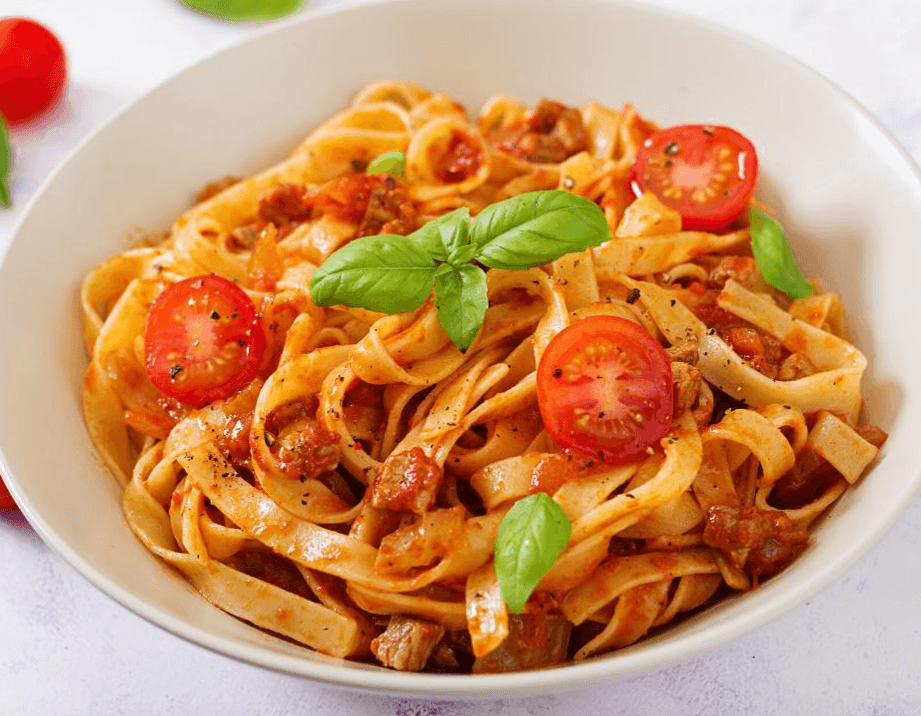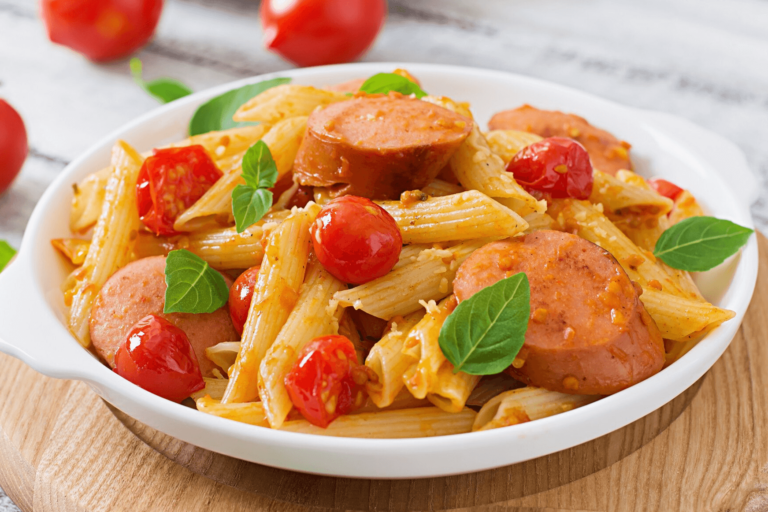What is Sausage Ragu?
Sausage ragu delivers a rich and hearty Italian flavor. This classic sauce combines savory sausage, tomatoes, and aromatic vegetables. Its deep flavor makes it a favorite for elevating pasta dishes.
Pair it with tagliatelle, pappardelle, or rigatoni for a comforting and satisfying meal. Unlike bolognese, which blends various meats, sausage ragu showcases the bold flavors of sausage. Cooks often enhance these flavors with fennel, wine, and fresh herbs. For a detailed guide on perfecting your sauce, explore this resource on ragu basics.
Why Make Sausage Ragu at Home?
Cooking sausage ragu at home gives you control over the flavors. Choose mild or spicy sausage to suit your preferences. Fresh herbs like basil or oregano add layers of complexity. You can also incorporate creamy ingredients, such as mascarpone or heavy cream, for extra richness.
Homemade ragu provides fresher, more vibrant flavors than store-bought options. It’s also a budget-friendly choice and ideal for meal prep. Leftovers can serve as a topping for roasted potatoes and carrots, turning them into a rustic, flavorful dish. Follow this guide for inspiration.
Variations of Sausage Ragu
Regional Takes on Sausage Ragu
Italian cuisine offers diverse interpretations of sausage ragu. Each region adds its signature twist, making this dish endlessly customizable. Here are a few popular variations:
- Tuscan Sausage Ragu: This version includes cream and sage for a rich, velvety texture. It pairs beautifully with pappardelle.
- Southern Italian Ragu: Southern cooks often use spicy sausage and add fennel seeds. These additions create a bold, zesty flavor.
- Bologna-Style Ragu: This style uses a mix of meats, but sausage plays a starring role. The addition of red wine and fresh rosemary makes it stand out.
For more insight into regional Italian recipes, check out Great Italian Chefs.
Dietary Adaptations
Cooking sausage ragu at home lets you adapt the recipe to meet dietary needs. Here are a few easy ways to customize:
- Gluten-Free Ragu: Use gluten-free pasta or serve the sauce over polenta. Ensure the sausage is free from gluten-based fillers.
- Low-Carb Options: Swap traditional pasta for spiralized zucchini or spaghetti squash. These lighter bases highlight the rich flavors of the sauce.
- Vegetarian Twist: Replace the sausage with plant-based alternatives. Add mushrooms or lentils to maintain the hearty texture.
Looking for additional ideas on adapting recipes? Explore these gluten-free ingredient tips.
Creamy Sausage Ragu
For a decadent twist, try a creamy version of sausage ragu. Add mascarpone, heavy cream, or a dollop of ricotta cheese during the final stages of cooking. This variation pairs exceptionally well with gnocchi or polenta.
Pairings and Serving Suggestions
Best Pasta Pairings for Sausage Ragu
Choosing the right pasta can elevate your sausage ragu to a restaurant-quality dish. Here are the best options:
- Tagliatelle: This wide, flat pasta holds the sauce perfectly, ensuring each bite is flavorful.
- Pappardelle: Slightly wider than tagliatelle, pappardelle offers a rustic feel that complements the richness of the ragu.
- Rigatoni: Its ridges help capture chunks of sausage and sauce, delivering a hearty experience.
For a gluten-free twist, try pairing the ragu with polenta or a bed of mashed cauliflower. If you’d like to explore pairing pasta shapes with sauces, check out this guide to pasta pairings.
Wine and Beverage Pairings
The right beverage enhances the depth of your sausage ragu. Here are some perfect pairings:
- Red Wines: A robust Chianti or Sangiovese complements the sauce’s acidity and spices.
- White Wines: For a lighter touch, pair the dish with a crisp Pinot Grigio or Sauvignon Blanc.
- Non-Alcoholic Options: Sparkling water with a slice of lemon or herbal teas like chamomile bring balance to the meal.
For more inspiration on selecting wines for Italian dishes, explore Wine Enthusiast’s guide.
Creative Uses for Leftovers
Leftover sausage ragu can shine in other recipes. Here are a few ideas:
- Ragu-Stuffed Bell Peppers: Spoon the sauce into hollowed bell peppers, sprinkle with cheese, and bake.
- Ragu Pizza: Spread the sauce over pizza dough, top with mozzarella, and bake for a quick dinner.
- Breakfast Burrito: Add the ragu to scrambled eggs and wrap it in a tortilla for a hearty breakfast. Check out this easy breakfast burrito recipe for inspiration.
FAQs on Sausage Ragu

What is Sausage Ragu Made Of?
This Italian recipe consists of a few key ingredients that combine to create a rich and flavorful sauce. These include:
- Sausage (Italian, fennel, or spicy varieties)
- Aromatic vegetables like onions, garlic, celery, and carrots
- Tomatoes (canned, fresh, or crushed)
- Herbs such as basil, oregano, or parsley
- Optional ingredients like red wine, cream, or cheese for added depth
The choice of sausage significantly influences the flavor profile of the dish. For example, fennel sausage adds a mild sweetness, while spicy sausage brings heat.
What is a Ragù Made Of?
Traditional ragù is a meat-based Italian sauce that often uses beef, pork, or veal. The sauce features a combination of finely chopped vegetables (carrots, celery, and onions), tomatoes, and wine. While bolognese is a type of ragù, sausage-based variations like sausage ragu focus solely on the rich flavor of the sausage.
What is the Difference Between Bolognese and Ragù?
The key difference lies in the ingredients and consistency:
- Ragù: This is a broader category of Italian meat sauces, often including larger chunks of meat.
- Bolognese: A specific type of ragù from Bologna, it combines ground meat with a creamy texture from milk or cream.
If you’re curious about more Italian cooking techniques, check out MasterClass Cooking Techniques.
What is a Meat Ragù?
A meat ragù is a slow-simmered sauce that incorporates meats like beef, pork, sausage, or veal. The long cooking process allows the flavors to meld, resulting in a deeply flavorful dish. Meat ragù can serve as a pasta topping, pizza sauce, or even a filling for lasagna.
How Do You Make Creamy Sausage Ragu?
To make a creamy variation, stir in mascarpone, heavy cream, or ricotta cheese during the final minutes of cooking. This step adds richness and balances the acidity of the tomatoes. Pair it with gnocchi or polenta for a truly indulgent experience.
Easy Sausage Ragu Recipe
Making the meal doesn’t have to be time-consuming. Try this streamlined process:
- Sauté onions, carrots, celery, and garlic in olive oil.
- Brown the sausage, breaking it into smaller pieces.
- Add wine to deglaze the pan and enhance flavor.
- Stir in tomatoes, herbs, and optional spices.
- Simmer for 20–30 minutes and serve over your favorite pasta.
For more tips on easy pasta recipes, visit Simply Recipes.
What’s the Best Sausage Ragu Recipe?
The best recipe is one that matches your taste preferences. Use high-quality sausage and fresh herbs to maximize flavor. Experiment with ingredients like red wine, cream, or Parmesan to customize the sauce.
What is Tuscan Sausage Ragu?
Tuscan sausage ragu features cream, sage, and often white wine. This regional version has a lighter, velvety texture compared to traditional tomato-based ragù. It pairs wonderfully with pappardelle or polenta.
What is Fennel Sausage Ragu?
Fennel sausage ragu uses sausage infused with fennel seeds for a subtly sweet and aromatic flavor. This variation works well with spicy notes like chili flakes or a touch of red pepper.
Expert Tips and Tricks for Perfect Sausage Ragu
1. Balance the Flavors
Balancing flavors is crucial to making a standout sausage ragu. Here’s how you can achieve the perfect taste:
- Add a splash of wine to enhance depth. Use red wine for richness or white wine for a lighter touch.
- Balance acidity with a pinch of sugar or a splash of cream if your tomatoes are too tart.
- Incorporate fresh herbs like basil and parsley toward the end of cooking for a burst of freshness.
Check out these Italian cooking secrets for more ways to elevate your dish.
2. Choose Quality Ingredients
High-quality ingredients make all the difference. Start with fresh Italian sausage from a trusted butcher or market. Look for bright, ripe tomatoes or opt for premium canned varieties like San Marzano. Choose extra virgin olive oil for its fruity, rich flavor.
3. Build Layers of Flavor
Cooking sausage ragu requires patience and technique. Follow these steps to create complex flavors:
- Sauté aromatics slowly until softened and fragrant. This builds a rich base for your sauce.
- Brown the sausage thoroughly. Don’t rush this step—it’s key to unlocking deep, caramelized flavors.
- Simmer the sauce for at least 30 minutes to meld the flavors. Longer cooking times deepen the sauce’s complexity.
For a guide to mastering cooking techniques like these, visit MasterClass Cooking Techniques.
4. Perfect the Consistency
The consistency of your sausage ragu should be thick and cling to the pasta. If the sauce feels too thin, simmer it uncovered to reduce the liquid. For a creamier texture, stir in a bit of ricotta or mascarpone.
5. Make It Ahead of Time
Sausage ragu often tastes better the next day. Prepare it a day in advance to allow the flavors to deepen. Store it in the refrigerator, then reheat it gently on the stove before serving.
Preparation Time and Nutritional Facts
Preparation and Cooking Time
Making sausage ragu is straightforward, but timing is essential for achieving the best flavor. Here’s a breakdown of the time required:
| Step | Estimated Time |
|---|---|
| Ingredient Preparation | 10–15 minutes |
| Sautéing Aromatics | 10 minutes |
| Browning Sausage | 10 minutes |
| Simmering the Sauce | 30–40 minutes |
| Total Time | 60–75 minutes |
Nutritional Facts

The nutritional content of sausage ragu can vary depending on the sausage type, added ingredients, and serving size. Here’s an approximate breakdown for a single serving (1 cup of sauce):
| Nutrient | Amount per Serving |
|---|---|
| Calories | 320–350 kcal |
| Protein | 20–25 g |
| Total Fat | 22–25 g |
| Saturated Fat | 8–10 g |
| Cholesterol | 55–65 mg |
| Carbohydrates | 10–12 g |
| Dietary Fiber | 2–3 g |
| Sugars | 5–6 g |
| Sodium | 800–900 mg |
Note: Nutritional values can vary based on specific ingredients and portion sizes. For a lighter option, use lean sausage and limit the addition of cream or cheese.
Why Sausage Ragu Deserves a Place in Your Kitchen
Sausage ragu isn’t just a sauce—it’s a celebration of comforting, home-cooked meals. Its rich, savory flavors pair perfectly with pasta, polenta, or even roasted vegetables. This versatile dish brings warmth to your table and allows for endless customization. Whether you prefer a creamy Tuscan variation or a spicy Southern twist, sausage ragu can adapt to your tastes.
Cooking it at home ensures a fresher, healthier, and more flavorful meal compared to store-bought options. Plus, it’s an excellent recipe to share with family or friends, making it perfect for any occasion.
Experiment and Share Your Creations
Now that you know how to make sausage ragu, it’s time to roll up your sleeves and get cooking! Experiment with different sausage types, add your favorite herbs, and try pairing it with a variety of sides. Don’t forget to repurpose any leftovers for creative dishes like stuffed bell peppers or breakfast burritos.
We’d love to see how you make this dish your own! Share your sausage ragu creations on social media and tag us. For more recipes and inspiration, explore the latest guides on 30-Minute Recipes.

